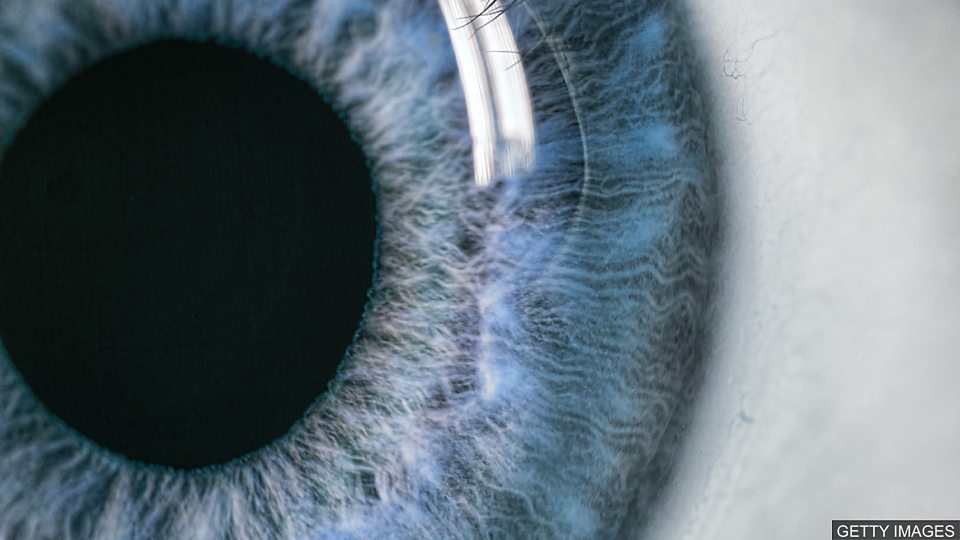还记得让你怀疑自己视力的那条 “白金蓝黑裙” 吗?你认为那条连衣裙到底是什么颜色的呢?你有没有想过我们是否都能看到同样的颜色?比如:你看到的是红色,而其他人看到的可能是蓝色。本文讨论人眼分辨颜色背后的科学。
词汇:sight 视力
Have you ever wondered if you see the same colours as other people? Most people know what blue is when they see it. It’s the colour of sea, sky and sapphires. They see the colour and call it ‘blue’ because they were taught the word and associated it with what they saw. But how do you know what you see as blue isn’t someone else’s red, and vice versa?
The ability to perceive different colours is down to receptors in our eyes known as cones. Light waves hit these receptors and they react depending on which colour the light is, sending signals to the brain. The brain then decodes these signals to determine which colour light the eyes are receiving.
Some people’s receptors are more developed than others. People with weaker receptors usually have colour blindness. The inability of the receptor to interpret the light waves correctly means that some people cannot distinguish between different shades of a colour.
Those with more enhanced receptors can see more shades of one colour, which is the first way in which people may see colours differently from each other. We sometimes hear people having an argument about whether something is dark blue or black. It might be because one person has stronger receptors to interpret the light than another.
In the past, most scientists would argue that everyone saw colours in the same way. However, research was conducted on monkeys, in which they were injected with a virus affecting their receptors. This enabled them to distinguish more colours than usual and brought an intriguing revelation. Normally monkeys can only see in blue and green, but the virus allowed monkeys to see red.
The neurons in their brains spontaneously adapted to be able to understand new colours, which might mean the neurons in our brains are not hardwired to automatically understand which colour is which. This implies that our brains and neurons may adapt depending on our stimulus during the developmental phase. Colour could be a very personal experience, unique to everyone.
So, the next time you talk about your favourite colour, just remember if yours is blue and your friend says red, you might actually be thinking about the same colour. What if everyone in the world has the same favourite colour, but just calls it different names?
词汇表
associate 与……联系起来
perceive 看待,认知
to be down to 是……责任,取决于
receptor 感受器
cone 晶状体,锥形体
light wave 光波
decode 解码
determine 决定
colour blindness 先天性色觉障碍,色盲
inability 无能力
enhanced 增强的,提高的
interpret 理解,阐释
intriguing 引人入胜的
revelation 被揭露的真相
neuron 神经细胞
spontaneously 自发地
hard-wired 本能的
imply 暗示,意味
stimulus 刺激
developmental 成长的,发展的
测验与练习
1. 阅读课文并回答问题。
1. How many colours can monkeys normally see?
2. Why do people have colour blindness?
3. True or false? We all see the same colour.
4. Why do we ‘know something is blue’?
5. What is it possible that the experiment on monkeys showed in relation to humans?
2. 选择意思恰当的单词或词组来完成下列句子。
1.You need to be a bit more _______ and innovative.
spontaneous spontaneity spontaneously spontaneous
2. The _______ of this decision are huge.
imply implied implies implications
3. I don’t enjoy _______ myself with them.
associate association associates associating
4. We need to give some toys to _______ the dog or she’ll destroy the house.
stimulate stimulating stimulation stimulates
5. This is an _______ of what I saw.
interpret interprets interpreted interpretation
答案
1. 阅读课文并回答问题。
1. How many colours can monkeys normally see?
They can normally only see two colours – green and blue.
2. Why do people have colour blindness?
The receptors in their eyes may be weaker or not as well formed.
3. True or false? We all see the same colour.
False. While people still aren’t sure if we see totally different colours, the level of shades we can see depends on the cones in our eyes.
4. Why do we ‘know something is blue’?
Because we learnt to associate what we saw with a word.
5. What is it possible that the experiment on monkeys showed in relation to humans?
That our eyes are not hard-wired to automatically know colours.
2. 选择意思恰当的单词或词组来完成下列句子。
1. You need to be a bit more spontaneous and innovative.
2. The implications of this decision are huge.
3. I don’t enjoy associating myself with them.
4. We need to give some toys to stimulate the dog or she’ll destroy the house.
5. This is an interpretation of what I saw.


 3342次下载
点击下载
3342次下载
点击下载
 2621次下载 点击下载
2621次下载 点击下载
 4734次下载 点击下载
4734次下载 点击下载
 1854次下载 点击下载
1854次下载 点击下载
 1391次下载 点击下载
1391次下载 点击下载
 1391次下载 点击下载
1391次下载 点击下载











